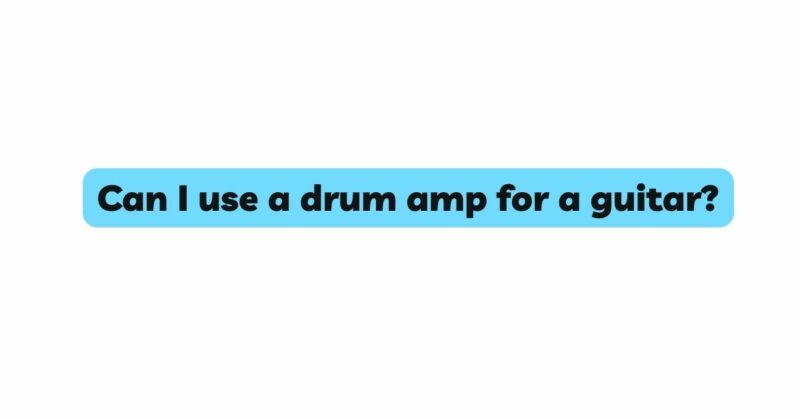In the ever-evolving landscape of music, experimentation and innovation continually push the boundaries of traditional practices. Instruments and their amplification are no exception, often prompting musicians to question conventions and explore new possibilities. One such query that frequently emerges is: Can I use a drum amp for a guitar? This article delves into the realm of musical curiosity, uncovering the potential, challenges, and creative outcomes of utilizing a drum amp as an alternative amplification solution for guitars.
Understanding Drum Amplifiers
Before diving into the prospect of using a drum amp for a guitar, it’s essential to grasp the fundamentals of drum amplifiers. Drum amps, also known as drum monitors, are specifically engineered to amplify the intricate percussive tones produced by drum kits. These amplifiers emphasize clarity, definition, and even sound dispersion to assist drummers in hearing themselves and their bandmates during live performances or rehearsals.
Drum amplifiers are meticulously designed to capture the diverse frequency range of percussion instruments, from the deep resonance of bass drums to the sharp shimmer of cymbals. Unlike guitar amplifiers that often feature built-in effects and tonal enhancements, drum amps generally prioritize accurate sound representation without significant tonal coloration.
Exploring the Drum Amp for Guitar
The idea of using a drum amp for a guitar introduces a realm of creative possibilities. From a technical standpoint, it is indeed feasible to connect a guitar to a drum amp using the appropriate cables and connectors. However, this unconventional approach raises questions about the tonal characteristics, frequency response, and sonic outcome of such a combination.
Frequency Response and Tonal Characteristics
One of the key considerations when using a drum amp for a guitar is the difference in frequency response between the two instruments. Guitars primarily operate within the mid-range frequencies, generating melodic lines, chords, and solos that require clarity and articulation. Drum amps, on the other hand, are tailored to the complex frequency spectrum of percussion instruments.
While it is possible to play a guitar through a drum amp, the resulting tonal characteristics may differ from those of a traditional guitar amplifier. Drum amps may emphasize frequencies outside the guitar’s natural range, potentially leading to imbalances in the sound projection. Adjustments to the amp’s EQ settings might be necessary to achieve a more guitar-friendly tonal balance.
Sound Projection and Amplifier Power
Another factor to consider is the sound projection and amplifier power when using a drum amp for a guitar. Drum amplifiers are engineered to project the nuanced dynamics of percussion instruments, which can differ significantly from the dynamics of a guitar’s notes and chords. The amplifier’s response to the varying dynamics of a guitar performance may impact the overall sonic experience.
Additionally, the power of the drum amp should be assessed to ensure it can handle the demands of a guitar’s output. Guitars produce both sustained and transient sounds, such as plucked strings and string bends. Ensuring that the amplifier can accommodate these dynamics without distortion or strain is essential for maintaining sound quality.
Tonal Adaptations and Experimentation
To optimize the use of a drum amp for a guitar, adaptation and experimentation are key. External equalization tools and pedals can help tailor the guitar’s sound to better suit the drum amp’s frequency response. Adjusting the amp’s EQ settings and experimenting with different sound adjustments can help achieve a more harmonious sonic outcome.
Creative guitarists might also embrace the unique characteristics of a drum amp to craft innovative sounds. The drum amp’s emphasis on clarity and definition could lead to unexpected tonal textures, creating a distinctive sonic identity that sets the music apart from traditional guitar amplification.
Considering Context and Intention
Ultimately, the decision to use a drum amp for a guitar hinges on the context and intention of the musical performance. Using a drum amp for a guitar might be appropriate in experimental or avant-garde contexts where unique sonic exploration is valued. It can also be an interesting solution for intimate performances or recording setups where a dedicated guitar amp might not be available.
However, it’s essential to acknowledge the tonal differences and potential challenges that may arise. Depending on the desired outcome, using a drum amp for a guitar can yield intriguing results that expand the sonic possibilities of both instruments.
Conclusion
In conclusion, the prospect of using a drum amp for a guitar represents a fascinating intersection of musical experimentation and innovation. While it is technically feasible to connect a guitar to a drum amp, the resulting tonal characteristics, frequency response, and sonic projection may differ from traditional guitar amplification.
Musicians who choose to explore this unconventional avenue should consider factors such as frequency response, sound projection, and tonal balance. Adaptation, experimentation, and a willingness to embrace sonic differences can lead to creative outcomes that contribute to a distinctive musical identity.
Ultimately, the decision to use a drum amp for a guitar should be guided by the artistic vision, context of the performance, and the desire to push the boundaries of sonic exploration in the ever-evolving world of music.

